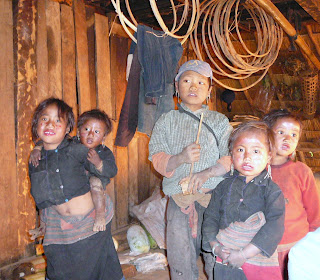
He comes over and shakes our hand and thanks us for bringing the medicine. He invites us to see his home, which, besides having the usual dead rats hanging from the ceiling, also has a haunch of a pig hanging from the wall.


It still looks quite fresh. It will last the chiefs family many days and will go off after a few days, and smell terrible, but they will still eat it. The chief invites us to stay for lunch and promises us that we will get some meat, which is a great honour. However, there is no way either of us wants to eat anything here. We ask the guide if we can decline the offer without causing any offence, by saying we have already eaten. He explains this to the Chief, who fortunately understands.
We leave the village with the children waving goodbye and running after us. The people have been wonderfully warm and friendly, but our flesh is crawling and we want nothing more than hot water and soap. Unfortunately neither is available. We do come to a stream, where we stop and wash our hands. We have brought with us a picnic of fried rice which we sit and eat by the stream. We discover a group sharing their lunch nearby.


It is a beautiful spot, miles from the nearest road. There are huge brightly coloured butterflies all round us, and the only sounds come from the myriad of birds singing in the tropical trees, and three young children from a neighbouring village playing downstream.

Trekking is not my forte, but this is quite magical. We gather up the plastic bags, water bottles and containers that we carried our picnic up in, and give them to some passing tribes people who are thrilled. They can put them to good use in their homes. This is a true example of recycling.






















